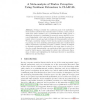Free Online Productivity Tools
i2Speak
i2Symbol
i2OCR
iTex2Img
iWeb2Print
iWeb2Shot
i2Type
iPdf2Split
iPdf2Merge
i2Bopomofo
i2Arabic
i2Style
i2Image
i2PDF
iLatex2Rtf
Sci2ools
CMMR
2007
Springer
2007
Springer
A Meta-analysis of Timbre Perception Using Nonlinear Extensions to CLASCAL
Abstract. Seeking to identify the constituent parts of the multidimensional auditory attribute that musicians know as timbre, music psychologists have made extensive use of multidimensional scaling (mds), a statistical technique for visualising the geometric spaces implied by perceived dissimilarity. mds is also well known in the machine learning community, where it is used as a basic technique for dimensionality reduction. We adapt a nonlinear variant of mds that is popular in machine learning, Isomap, for use in analysing psychological data and re-analyse three earlier experiments on human perception of timbre. Isomap is designed to eliminate undesirable nonlinearities in the input data in order to reduce the overall dimensionality; our results show that it succeeds in these goals for timbre spaces, compressing the output onto well-known dimensions of timbre and highlighting the challenges inherent in quantifying differences in spectral shape.
| Added | 07 Jun 2010 |
| Updated | 07 Jun 2010 |
| Type | Conference |
| Year | 2007 |
| Where | CMMR |
| Authors | John Ashley Burgoyne, Stephen McAdams |
Comments (0)

